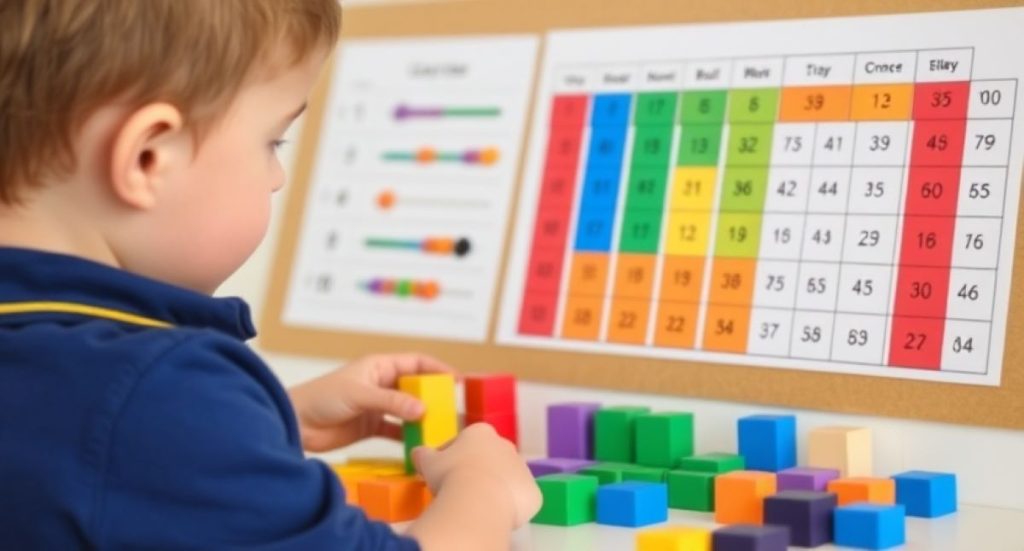What is Dyscalculia
Dyscalculia is a specific learning difficulty that affects a child’s ability to understand, process, and work with numbers. Often referred to as “math dyslexia,” it can make everyday tasks like telling time, counting money, or even solving basic arithmetic problems significantly more challenging. For parents, teachers, teacher aides, and caregivers, providing the right dyscalculia support strategies can make all the difference in helping children with dyscalculia build confidence and develop the math skills they need to succeed academically. AUSPELD defines dyscalculia as: “a condition that affects the ability to acquire arithmetical skills. Learners with dyscalculia may have difficulty understanding simple number concepts, lack an intuitive grasp of numbers, and have problems learning number facts and procedures. Even if they produce a correct answer or use a correct method, they do so mechanically and without confidence (Auspeld, 2019, p. 10)”.
Research suggests that 3 – 6% of students in Australia have dyscalculia, yet there is a lack of diagnosis of dyscalculia despite the fact that the behavioural characteristics of dyscalculia are generally well defined. Reasons for this may include the existence of other additional needs or learning disabilities, for example 50% of dyslexics have dyscalculia.
Dyscalculia is not treated with medication, however its impact can be managed and minimised through the use of a range of support strategies.
Indicators of Dyscalculia
Preschool
Learners can have unexpected difficulty with:
- learning to count and connecting numbers to groups of things
- recognising patterns, number symbols and sorting objects (colour, shape, size)
- an accurate sense of time.
Junior Primary school
Learners can have unexpected difficulty with:
- organising objects and sets of items in a logical way
- using counting strategies (counting in 2’s, 5’s and so on) and counting on
- mastering number knowledge (recognising how many items make a set without counting)
- remembering arithmetic facts and decomposing numbers.
Primary school
Learners can have unexpected difficulty with:
- inattention to numerical operator
- multi-step calculation procedures and delays in applying concepts of place value
- telling the time and recalling times tables and retrieval of overlearned number facts
- measurement and understanding spatial relationships.
Secondary school
Learners can have unexpected difficulty with:
- learning and recognising mathematics vocabulary and mathematics concepts
- finding more than one way to solve a mathematics problem
- reading and interpreting graphs, charts and maps and delays in spatial directions.
To diagnose dyscalculia in children a formal assessment must be conducted by a psychologist. This is often required by schools in order to facilitate strategies and additional support.
To learn more about support for students with Dyscalculia in Australia refer to your State Education Departments website or check out the SPELD association in your State: AUSPELD

Dyscalculia Support Strategies
1. Use Visual Aids and Manipulatives
Children with dyscalculia often struggle with abstract mathematical concepts, so visual aids and concrete manipulatives can be powerful tools. These hands-on materials help bridge the gap between abstract math concepts and real-world understanding.
- Number lines: Use number lines to help children visualize the relationship between numbers, especially for addition and subtraction.
- Counters or blocks: Physical objects like counters or blocks can be used to demonstrate basic math operations, helping children visualize grouping, addition, subtraction, and even multiplication.
- Colored markers and charts: Using color-coded materials can help with organizing and identifying different types of numbers or mathematical operations.
These tactile tools allow children to grasp mathematical concepts in a more concrete way, giving them something to physically manipulate and connect with the task at hand.

2. Provide Step-by-Step Instructions
Children with dyscalculia often have difficulty with multi-step processes and can become easily overwhelmed by complex problems. Breaking down tasks into smaller, manageable steps can make learning more accessible and less stressful.
- Chunking: Break down larger problems into smaller “chunks.” For example, when teaching multi-digit multiplication, divide the process into smaller steps such as multiplying each digit separately before combining results.
- Use clear, simple language: Avoid using complex explanations. Instead, give one simple instruction at a time to help the child focus on each part of the process.
Taking time to reinforce each step before moving on to the next will help build a solid foundation, allowing the child to move forward with confidence.
3. Use Technology and Apps
There are many educational apps and software tools designed to support children with dyscalculia. Technology can provide interactive, engaging, and personalized ways to practice math skills while accommodating different learning styles.
- Interactive math games: Apps like “ModMath” and “Dyscalculia Toolkit” offer interactive environments where children can practice math problems in a fun, engaging way.
- Visual aids: Digital tools like virtual number lines and math apps with built-in step-by-step guides can be customized to suit a child’s individual needs.
- Equation solving digital tools: these tools prompt learners through the problem-solving process. For example iDevBooks is a large collection of evidence-based mathematics apps.
- Socratic: will find the best resources to help with mathematic concepts from a picture you take of the problem.
Technology not only makes learning more engaging but also helps students practice independently, reinforcing concepts in a non-threatening environment.

4. Incorporate Real-World Applications
Relating math problems to real-world scenarios helps children understand why math is relevant and how it can be used practically. This approach can make math feel less abstract and more applicable to everyday life.
- Money management: Use play money to teach counting and basic addition and subtraction skills, and allow children to simulate buying items to practice making change.
- Cooking and measurements: When cooking together, children can practice measuring ingredients, doubling or halving recipes, and understanding fractions in a hands-on way.
- Time management: Help children practice telling time using a clock with both digital and analog faces, and involve them in activities that require time calculation, like setting timers or planning events.
By using practical examples, you can reinforce mathematical concepts in ways that children can directly relate to their own experiences.

5. Provide Frequent and Positive Feedback
Children with dyscalculia often experience frustration and a lack of self-confidence in math. It’s essential to offer frequent praise for their efforts, no matter how small, and emphasize their progress rather than focusing on mistakes.
- Focus on effort: Praise the effort rather than just the outcome. Acknowledge the persistence and focus they put into solving a problem, even if they didn’t get the answer right.
- Create a supportive environment: Maintain a positive, patient, and non-judgmental tone when providing feedback. This helps reduce anxiety and encourages the child to take risks in problem-solving without fear of failure.
Building emotional resilience is key to fostering a positive attitude toward math, and with consistent support, children can gradually overcome their challenges.
6. Offer Extra Time and Flexible Testing
Standardized tests and timed math drills can be particularly challenging for children with dyscalculia. Providing extra time for assignments and tests can help alleviate pressure and allow students to fully process and complete tasks at their own pace.
Untimed assessments: Allow children to work at their own speed when completing math problems, especially when taking tests or completing homework assignments.
Reduce the number of problems: Instead of overwhelming children with long worksheets, reduce the number of problems or provide them in smaller sets.
Accommodations like extra time can help children feel less anxious and more capable of performing to the best of their ability.
7. Be Patient and Consistent
One of the most important strategies is to be patient and consistent. Dyscalculia is not something that children “outgrow” on their own, but with the right support, they can build the skills they need to manage their learning challenges.
Consistent practice: Like with any learning difficulty, regular practice is key. Providing frequent opportunities for children to work on their math skills, both in and outside the classroom, helps reinforce concepts and build familiarity.
Emphasize progress over perfection: Celebrate small wins along the way to show children that progress is more important than perfection. The goal is to build a strong, lasting understanding of math, rather than just completing tasks correctly on the first try.

Age-Based Adjustments
When selecting education support strategies for children with dyscalculia, you will need to consider the age of the child. Below is a guide on age suitable adjustements:
Kindy & Prep: Provide play-based learning for patterning to develop number sense and sequence. For example, use threading beads, clothes pegs, lacing cards and other small manipulatives. Incorporate the language of math in play-based learning activities to help language development, storytelling, and creativity.
Primary: Model and provide a worked example that underlies strategies and thinking. Use visual representations such as colour coding, and dots or pictures to represent numbers. Use concrete materials and manipulatives such as counting blocks.
Secondary: Provide examples of multi-step mathematic problems for students to refer back to. Use large amounts of white space or colour coding to highlight each step.
Conclusion
Supporting children with dyscalculia requires a combination of patience, creativity, and understanding. By providing hands-on learning tools, breaking down tasks, using technology, and offering consistent encouragement, children with dyscalculia can build the skills they need to succeed in math. It’s also crucial to maintain open communication with educators, as they can offer tailored support strategies and resources that help children learn at their own pace.
Ultimately, the goal is to foster a positive learning environment where children feel supported and empowered to take on the challenges of math, no matter what obstacles they may face. With the right strategies in place, children with dyscalculia can develop the skills and confidence they need to thrive academically and beyond.








